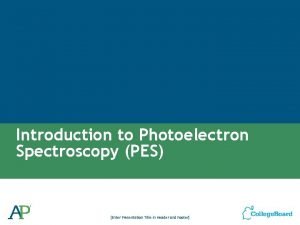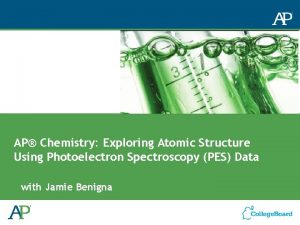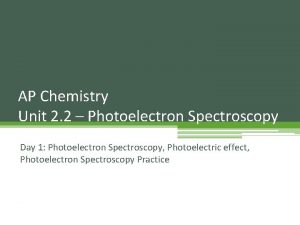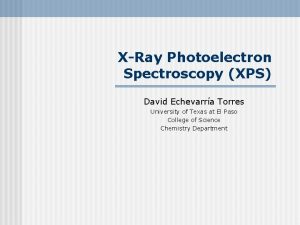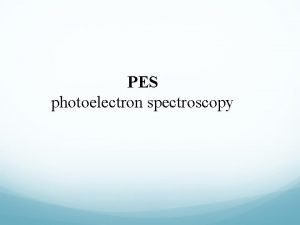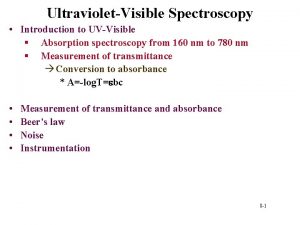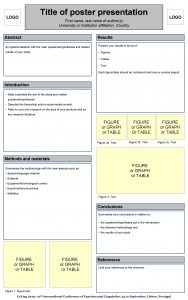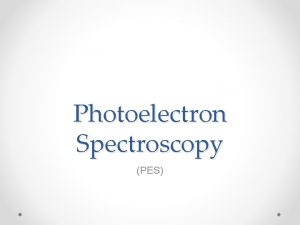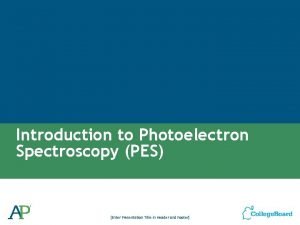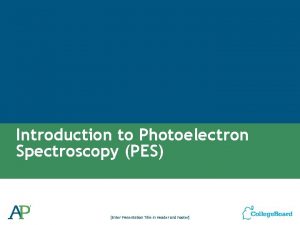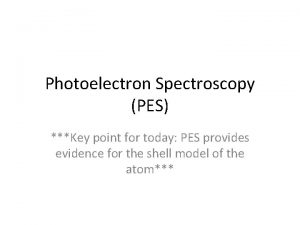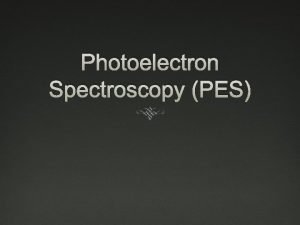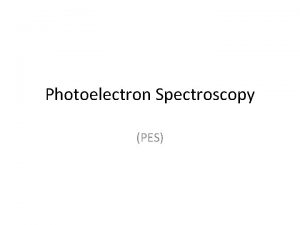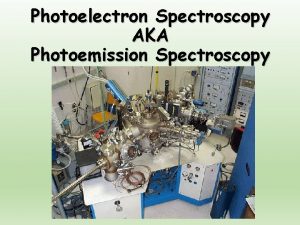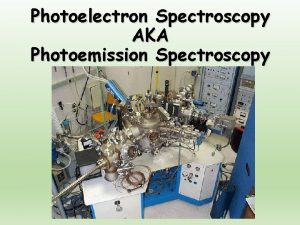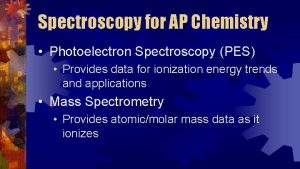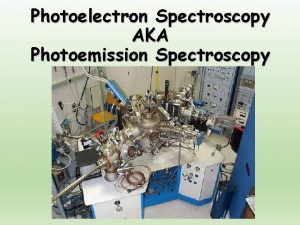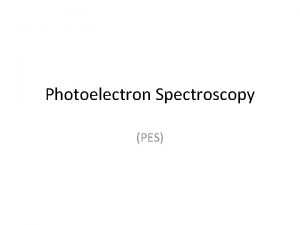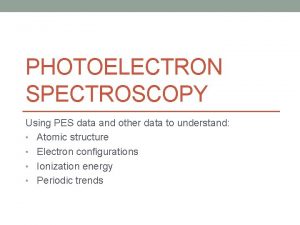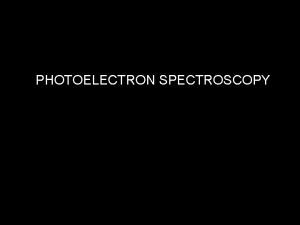Introduction to Photoelectron Spectroscopy PES Enter Presentation Title
![Introduction to Photoelectron Spectroscopy (PES) [Enter Presentation Title in Header and Footer] Introduction to Photoelectron Spectroscopy (PES) [Enter Presentation Title in Header and Footer]](https://slidetodoc.com/presentation_image_h/dd55be53d614f3503c6fc243c6ac1149/image-1.jpg)
![Not all elements ‘follow the rules’ 1 s [Ar]4 s 13 d 5 1 Not all elements ‘follow the rules’ 1 s [Ar]4 s 13 d 5 1](https://slidetodoc.com/presentation_image_h/dd55be53d614f3503c6fc243c6ac1149/image-2.jpg)
























- Slides: 26
![Introduction to Photoelectron Spectroscopy PES Enter Presentation Title in Header and Footer Introduction to Photoelectron Spectroscopy (PES) [Enter Presentation Title in Header and Footer]](https://slidetodoc.com/presentation_image_h/dd55be53d614f3503c6fc243c6ac1149/image-1.jpg)
Introduction to Photoelectron Spectroscopy (PES) [Enter Presentation Title in Header and Footer]
![Not all elements follow the rules 1 s Ar4 s 13 d 5 1 Not all elements ‘follow the rules’ 1 s [Ar]4 s 13 d 5 1](https://slidetodoc.com/presentation_image_h/dd55be53d614f3503c6fc243c6ac1149/image-2.jpg)
Not all elements ‘follow the rules’ 1 s [Ar]4 s 13 d 5 1 s [Ar]4 s 13 d 10 2 s 2 p 3 s 3 p 4 s 3 d 4 p 5 s 4 d 5 p 6 s 5 d 6 p 7 s 6 d 7 p 4 f 5 f

How do we know? hν - hν - +

Ionization Energy Image source: http: //chemistry. beloit. edu/stars/images/IEexpand. gif Image source: Dayah, Michael. “Dynamic Periodic Table. ” Accessed Sept. 5, 2013. http: //ptable. com/#Property/Ionization

Ionization Energy Element IE 1 IE 2 IE 3 IE 4 IE 5 IE 6 IE 7 Na 495 4, 560 Mg 735 1, 445 7, 730 Al 580 1, 815 2, 740 11, 600 Si 780 1, 575 3, 220 4, 350 16, 100 P 1, 060 1, 890 2, 905 4, 950 6, 270 21, 200 S 1, 005 2, 260 3, 375 4, 565 6, 950 8, 490 27, 000 Cl 1, 255 2, 295 3, 850 5, 160 6, 560 9, 360 11, 000 Ar 1, 527 2, 665 3, 945 5, 770 7, 230 8, 780 12, 000 LO 1. 5 - The student is able to explain the distribution of electrons in an atom or ion based upon data. LO 1. 6 - The student is able to analyze data relating to electron energies for patterns or relationships.

How do we probe further into the atom? Radiation Type ν E Aspects Probed Microwaves 109 – 1011 Hz 10 -7 – 10 -4 MJ/mol Molecular rotations Infrared (IR) 1011 – 1014 Hz 10 -4 – 10 -1 MJ/mol Molecular vibrations Visible (ROYGBV) 4 x 1014 – 7. 5 x 1014 Hz 0. 2 - 0. 3 MJ/mol Ultraviolet (UV) 1014 – 1016 Hz X-ray 1016 – 1019 Hz hν - - - 11+ - 102 – 105 MJ/mol - - hν 0. 3 – 100 MJ/mol - Valence electron transitions in atoms and molecules Core electron transitions in atoms

Removing Core Electrons - - 11+ hν - - Radiation Type X-ray ν 1016 – 1019 Hz E 102 – 105 MJ/mol Aspects Probed Core electron transitions in atoms

Removing Core Electrons hν - - 11+ hν - - - - Any frequency of light that is sufficient to remove electrons from the 1 st shell can remove electrons from any of the other shells.

PES Instrument Image Source: SPECS Gmb. H, http: //www. specs. de/cms/front_content. php? idart=267

Kinetic Energy Analyzer Kinetic X-ray or UV Source 6. 26 0. 52 Binding Energy (MJ/mol) 3+ 3+ 3+ 3+ 3+

Kinetic Energy Analyzer Kinetic X-ray or UV Source Li 6. 26 Binding Energy (MJ/mol) Boron 1. 36 0. 80 19. 3 5+ 5+ 3+ 3+ 5+ 5+ 3+ 3+ 5+ Binding Energy (MJ/mol) 5+ 3+ 3+ 5+ 0. 52 5+ 3+ 3+ 5+ 5+ 3+

Analyzing Data from PES Experiments

Relative Number of Electrons Analyzing data from PES 2 p 2. 0 1 s 2 s 84. 0 4. 7 + 90 80 70 60 50 40 30 20 10 Binding Energy (MJ/mol) Which of the following elements might this spectrum represent? (A)He (B)N (C)Ne (D)Ar 0

Relative Number of Electrons Analyzing data from PES 2 p 6 7. 9 1 s 2 2 s 2 3 s 2 151 12. 1 1. 09 3 p 1 0. 58 100 10 1 Binding Energy (MJ/mol) Given the spectrum above, identify the element and its electron configuration: (A)B (B)Al (C)Si (D)Na

PES Sample Questions

Sample Question #1 Relative Number of Electrons Which element could be represented by the complete PES spectrum below? 100 10 (A) Li 1 Binding Energy (MJ/mol) (B) B (C) N 0. 1 (D) Ne

Sample Question #2 Intensity Which of the following best explains the relative positioning and intensity of the 2 s peaks in the following spectra? Li 12 10 8 6 4 Binding Energy (MJ/mol) 2 0 Intensity 14 Be 14 (A) (B) (C) (D) 12 10 8 6 4 Binding Energy (MJ/mol) 2 0 Be has a greater nuclear charge than Li and more electrons in the 2 s orbital Be electrons experience greater electron-electron repulsions than Li electrons Li has a greater pull from the nucleus on the 2 s electrons, so they are harder to remove Li has greater electron shielding by the 1 s orbital, so the 2 s electrons are easier to remove

Sample Question #3 Given the photoelectron spectra above for phosphorus, P, and sulfur, S, which of the following best explains why the 2 p peak for S is further to the left than the 2 p peak for P, but the 3 p peak for S is further to the right than the 3 p peak for P? Binding Energy (A) S has a greater effective nuclear charge than P, and the 3 p sublevel in S has greater electron repulsions than in P. (B) S has a greater effective nuclear charge than P, and the 3 p sublevel is more heavily shielded in S than in P. (C) S has a greater number of electrons than P, so the third energy level is further from the nucleus in S than in P. (D) S has a greater number of electrons than P, so the Coulombic attraction between the electron cloud and the nucleus is greater in S than in P.

Sample Question #4 Intensity (c/s) Looking at the complete spectra for Na and K below, which of the following would best explain the relative positioning of the 3 s electrons? Na 105 90 75 60 45 Binding Energy (MJ/mol) 30 15 0 Intensity (c/s) 130 K 400 350 300 250 200 150 Binding Energy (MJ/mol) 100 50 0

Sample Question #4 a 4 (A) (B) (C) (D) 3. 5 3 Na-3 s K-3 s Intensity (c/s) Looking at the spectra for Na and K below, which of the following would best explain the difference in binding energy for the 3 s electrons? 2. 5 2 1. 5 Binding Energy (MJ/mol) 1 0. 5 K has a greater nuclear charge than Na K has more electron-electron repulsions than Na Na has one valence electron in the 3 s sublevel Na has less electron shielding than K 0

Sample Question #4 b 4 (A) (B) (C) (D) 3. 5 3 Na-3 s K-3 s Intensity (c/s) Looking at the spectra for Na and K below, which of the following would best explain the difference in signal intensity for the 3 s electrons? 2. 5 2 1. 5 Binding Energy (MJ/mol) 1 0. 5 K has a greater nuclear charge than Na K has more electron-electron repulsions than Na Na has one valence electron in the 3 s sublevel Na has less electron shielding than K 0

Sample Question #5 Intensity (counts/s) Given the photoelectron spectrum below, which of the following best explains the relative positioning of the peaks on the horizontal axis? Image source: http: //www. rsc. org/ej/JM/2010/b 925409 a-f 2. gif (A) O has more valence electrons than Ti or C, so more energy is required to remove them (B) O has more electron-electron repulsions in the 2 p sublevel than Ti and C (C) Ti atoms are present in a greater quantity than O can C in the mixture. (D) Ti has a greater nuclear charge, but the 2 p sublevel experiences greater shielding than the 1 s sublevel.

Sample Question #6 Intensity (c/s) Given the photoelectron spectrum of scandium below, which of the following best explains why Scandium commonly makes a 3+ ion as opposed to a 2+ ion? 0. 63 0. 77 500 400 300 50 40 30 10 9 8 7 6 5 4 3 2 1 0 Binding Energy (MJ/mol) (A) Removing 3 electrons releases more energy than removing 2 electrons. (B) Scandium is in Group 3, and atoms only lose the number of electrons that will result in a noble gas electron configuration (C) The amount of energy required to remove an electron from the 3 d sublevel is close to that for the 4 s sublevel, but significantly more energy is needed to remove electrons from the 3 p sublevel. (D) Removing 2 electrons alleviates the spin-pairing repulsions in the 4 s sublevel, so it is not as energetically favorable as emptying the 4 s sublevel completely.

Example Formative Assessment Intensity On the photoelectron spectrum of magnesium below, draw the spectrum for aluminum 100 10 Binding Energy (MJ/mol) 1 Hint: for additional formative assessments, use spectra from previous multiple choice questions

Intensity Quick Check – Can You Now Translate Between These Representations of Mg? 100 10 Binding Energy (MJ/mol) - 4 s 3 p 3 s 2 p 2 s 1 s 1 Mg - - - 12+ - - - 1 s 2 2 p 6 3 s 2

Relative Number of Electrons PES – Data that Shells are Divided into Subshells 2 p 6 7. 9 1 s 2 2 s 2 3 s 2 151 12. 1 1. 09 100 10 IE 4 0. 58 1 Binding Energy (MJ/mol) IE 3 3 p 1 Element IE 1 IE 2 IE 5 IE 6 IE 7 Na 495 4560 Mg 735 1445 7730 Al 580 1815 2740 11, 600 Si 780 1575 3220 4350 16, 100 P 1060 1890 2905 4950 6270 21, 200 S 1005 2260 3375 4565 6950 8490 27, 000 Cl 1255 2295 3850 5160 6560 9360 11, 000 Ar 1527 2665 3945 5770 7230 8780 12, 000
 Draw a photoelectron spectrum for aluminum
Draw a photoelectron spectrum for aluminum Photoelectron spectroscopy ap chemistry
Photoelectron spectroscopy ap chemistry Pes spectrum for magnesium
Pes spectrum for magnesium Xray photoelectron spectroscopy
Xray photoelectron spectroscopy Pes spectroscopy
Pes spectroscopy Enter your title
Enter your title Applications of uv visible spectroscopy
Applications of uv visible spectroscopy Charge d'un électron
Charge d'un électron Reports and proposals
Reports and proposals Title title
Title title Poster presentation title
Poster presentation title Insert the sub title of your presentation
Insert the sub title of your presentation This is your presentation title
This is your presentation title This is your presentation title
This is your presentation title Poster presentation logo
Poster presentation logo Din a 0
Din a 0 Transition headline
Transition headline Name/title of presenter
Name/title of presenter This is your presentation title
This is your presentation title This is your presentation title
This is your presentation title Catchy title for presentation
Catchy title for presentation Diameters of fetal head
Diameters of fetal head 4 maneuvers of leopold
4 maneuvers of leopold Apa title lage
Apa title lage Introduction sample essay
Introduction sample essay Examples of introduction paragraph
Examples of introduction paragraph 1 page abstract
1 page abstract
